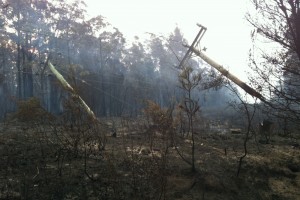Transforming Transmission
While the transformation of the generation sector dominates the headlines, the critical work to determine how all that new supply is connected – and who should pay what – is quietly powering ahead. We’re not yet half way through the year and already, 2018 is proving to be a year of significant transformation and disruption for the Australian energy sector. This week, we take a snapshot of several upcoming reports that have serious impacts.
When it comes to the many, interlinked institutional reviews that are underway concerning the NEM, we share in Marvin Gaye’s pertinent question; what’s going on? Will subsequent findings be music to our collective ears? A stock-take of what stakeholders and policy makers are currently considering, and what the NEM Institutions/bodies will publish over ensuing months reveals a busy landscape.
The Australian Energy Market Commission
Among the ‘live’ consultations currently underway are the Australian Energy Market Commission’s (AEMC) Review of Coordination of Generation and Transmission Investment’s Discussion Paper (focusing on Renewable Energy Zones), and the AEMC’s Reliability Frameworks Review Directions Paper. Submissions on both these reviews close in mid-May, with completion expected by mid-2018[1]. Energy Networks Australia notes some of the key considerations.
Coordination of Generation and Transmission Investment
- The level of existing network congestion might be a challenge in a number of NEM sub-regions – more so than the AEMC perhaps has considered
- There should be a principled and unambiguous regulatory approach to large scale storage facilities connecting to the transmission network
- Of the mooted AEMC options for Renewables Energy Zones (REZ) in the Discussion Paper that Option 1 – enhanced information provision – may be the less problematic than the generator coordination, TNSP speculation and TNSP prescribed service (build it and they will come) options. However, it’s unclear that any of the four options alone, will be able to strike the right balance between keeping costs down and delivering the transmission investment we need in a timely manner.
- The application process to connect generators may require significant review. Increased transparency and expediency would be improvements to the current processes, which some consider to be unnecessarily lengthy. Clustering or ‘’open season” connection application processes are being explored. This would mean connecting numerous generators simultaneously. In theory, there are benefits to such an approach. This might be further improved combined with enhanced information provision under a revised TNSP prescribed service arrangement.
The AEMC reports that a large number of submissions to AEMO’s Integrated System Plan (ISP) consultation put forward the case for amending the existing transmission investment approval (RIT-T) framework.
“[The framework should] be flexible enough to consider the benefits and economies of scale that can flow from strategic transmission investments..Therefore, a key question for stakeholders arising out of the ISP is how the RIT-T framework and the ISP, including REZs, will work together” (p.52).
We strongly agree that this is a fundamental issue for all the NEM institutions to address.
Reliability Frameworks Review
The AEMC is seeking stakeholder feedback on a number of important recommendations from the Finkel Review. These include:
- The on-going forecasting challenges facing the NEM. The AEMC proposes an entity that reports on actual outcomes, and potentially extending self-forecasting by utility scale wind and solar generators. Another reform in the offing might see distribution businesses undertaking forecasts for retailers.
- The suitability of a day-ahead market (DAM) for the NEM[2]. The AEMC considers that there are many features of a DAM already in play that can be incrementally improved. The AEMC is examining how a more formalised day ahead market might work.
- Requirements for a workable wholesale demand response (DR) mechanism and the role for DER in light of existing regulatory frameworks. This could address limitations with the current Market Ancillary Services framework and restrictions on the role of networks. A further improvement may be the modification of the current rule that allows one Financially Responsible Market Participant at a connection point. This practise arguably stifles customer involvement in DR.
- Deferring assessment of a strategic reserve mechanism[3] in relation to the current Reliability and Emergency Reserve Trader (RERT) arrangements to impending rule change proposals[4]. The AEMC maintains that some form of strategic reserve needs to be in place as a last resort to avoid involuntary load shedding.
Frequency Control Frameworks Review
Submissions for the AEMC’s Frequency Control Frameworks Review closed on 24 April 2018. The AEMC is currently examining ways to integrate new technologies, distributed energy resources (DER) and demand response to help keep the system secure. Expected by the end of July 2018, this review considers the implementation of several Finkel Review recommendations.
The implementation of the Finkel Report’s recommendations on the wide-ranging issue of Generator Technical Performance and Connection Standards is progressing at various speeds. At this stage, the AEMC is intending to release a draft determination on AEMO’s extensive 2017 rule change proposal on Generator Technical Performance Standards by 5 June 2018 and complete its rule change determination by early October 2018.
The Australian Energy Market Operator (AEMO)
AEMO’s inaugural Integrated System Plan (ISP) is to be published by June 2018 (Finkel recommendation 5.1). Submissions closed in March 2018. A key issue raised was whether the existing AER Regulatory Investment Test for Transmission is fit for purpose and able to cope with the anticipated energy transformation. A second stakeholder concern was the legality and regulatory standing of the ISP, and how best to establish REZs.
The Australian Energy Regulator (AER)[5]
In February 2018, the AER’s RIT Applications Guideline Review commenced. Submissions closed on 6 April 2018. The AER is expected to publish draft amendments to its application guidelines during late June/early July 2018. A key policy matter raised was how AEMO’s ISP should be incorporated in the AER guidance in the RIT application guidelines (i.e. Question 16 in its Issues Paper).
Start of COAG’s rule change on transmission connections
1 July 2018 ushers in the commencement of the new commercially competitive transmission connections arrangements, resulting from the AEMC’s Final Determination on the COAG Energy Council’s rule change proposal of May 2017.
The Energy Security Board
On 20 April 2018, the Energy Security Board released its National Energy Guarantee – High Level Design Document that commits to future workshops and working papers throughout May and June, with stakeholder input to inform the final design of the Guarantee in July 2018.
While the National Energy Guarantee was the headline act, it’s clear the COAG Energy Council also emphasised transmission issues at its recent meeting, with the paragraph below appearing in the Communique.
“Ministers agreed the Energy Security Board would have responsibility for coordinating the work of the energy market bodies on planning and regulation of the transmission system and interconnection, and report to ministers at the August 2018 meeting about the progress of this coordinated work”.
(Extract from the COAG Energy Council Meeting Communique – 20 April 2018).
Coordinating the work of all the market bodies makes sense in theory, but it’s not yet clear what this will mean in practice .
Energy Networks Australia’s position
Energy Networks Australia is calling for aligned, consistent, and practical outcomes from all reviews currently in train. The best results will come from a cohesive umbrella approach, rather than siloed, narrowed focus. Feedback should be considered and a collaborative pathway applied in order to bolster the NEM.
Energy Networks Australia is participating in all the above mentioned processes and we look forward to our feedback contributing to the development and security of a robust, working national energy system. All these moving pieces would inevitably be a challenge for a grandmaster chess player and there is no doubt this is a fast paced game in which we’re participating. Played right, we believe, everyone could come out a winner.
[1] The Terms of Reference for the Coordination of Generation and Transmission Investment Review requires completion of the Review by around 17 July 2018 – 12 months after the completion of Stage 1.
[2] An element of Finkel Report recommendation 3.4.where the AEMC and the AEMO were to collaborate.
[3] Ibid.
[4] On 26 April 2018, the AEMC commenced a rule change consultation proposed by AEMO on the Reinstatement of long notice Reliability and Emergency Reserve Trader. The second AEMO RERT-related rule change proposal entitled “Enhancement to the Reliability and Emergency Reserve Trader” is expected to commence consultation during June 2018.
[5] The AER is also currently conducting a consultation on its Transmission Annual Planning Report Guideline with submissions due 18 May 2018.



